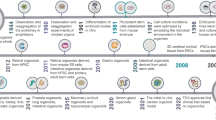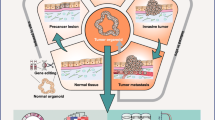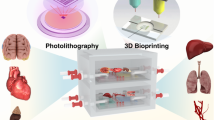Abstract
Purpose of Review
Cancer is often a complicated and dynamic disease, which makes determining the optimal treatment for a given patient a difficult endeavor. Moreover, even within a particular cancer type, different patients often have varying responses to the same therapies. Bioengineered tumor model systems specific to patients would allow preemptive screening of personalized therapies, facilitating identification of the most effective treatments prior to administration in the patients. Here, we provide an overview of organoid technology, and how these bioengineered tumor models can be harnessed for patient-centric personalized oncology.
Recent Findings
Organoid models have ranged from simple cell spheroids to more complex tumor-on-a-chip systems. The earliest of these models were comprised of easy to culture cell lines, but recent advances in 3D cell culture approaches have facilitated generation of human primary cell-based organoids. Importantly, recent efforts have been made to employ tumor biospecimens from human patients to create personalized tumor models for patient-specific predictive drug screening.
Summary
Bioengineering and tissue engineering technologies have advanced significantly in recent years, culminating in the capability to biofabricate tissue and tumor organoids derived from individual human patients. In the near future, we anticipate such models being implemented in parallel with clinical practice as patient-oriented screening tools, thereby improving the success rates of oncology.

Similar content being viewed by others
References
Papers of particular interest, published recently, have been highlighted as: • Of importance •• Of major importance
Mills M, Estes MK. Physiologically relevant human tissue models for infectious diseases. Drug Discov Today. 2016;21(9):1540–52.
Lancaster MA, Knoblich JA. Organogenesis in a dish: modeling development and disease using organoid technologies. Science. 2014;345(6194):1247125.
Skardal A, Shupe T, Atala A. Organoid-on-a-chip and body-on-a-chip systems for drug screening and disease modeling. Drug Discov Today. 2016;21(9):1399–411.
Pampaloni F, Reynaud EG, Stelzer EH. The third dimension bridges the gap between cell culture and live tissue. Nat Rev Mol Cell Biol. 2007;8(10):839–45.
Esch MB, King TL, Shuler ML. The role of body-on-a-chip devices in drug and toxicity studies. Annu Rev Biomed Eng. 2011;13:55–72.
Kang L, Chung BG, Langer R, Khademhosseini A. Microfluidics for drug discovery and development: from target selection to product lifecycle management. Drug Discov Today. 2008;13(1–2):1–13.
Astashkina A, Grainger DW. Critical analysis of 3-D organoid in vitro cell culture models for high-throughput drug candidate toxicity assessments. Adv Drug Deliv Rev. 2014;69-70:1–18.
• Zhang YS, Aleman J, Shin SR, Kilic T, Kim D, Mousavi Shaegh SA, et al. Multisensor-integrated organs-on-chips platform for automated and continual in situ monitoring of organoid behaviors. Proc Natl Acad Sci U S A. 2017;114(12):E2293–E302. This study describes organ-on-a-chip devices with a sophisticated biosensor suite that allows automated and real-time sensing of organoid health and behaviors
• Skardal A, Murphy SV, Devarasetty M, Mead I, Kang HW, Seol YJ, et al. Multi-tissue interactions in an integrated three-tissue organ-on-a-chip platform. Sci Rep. 2017;7(1):8837. This study demonstrates the development and implementation of multiple human organoids in a single perfused “body-on-a-chip” platform and showcases several integrated drug studies in which the function of one organoid type influences outcomes of the other organoid types
Skardal A, Devarasetty M, Rodman C, Atala A, Soker S. Liver-tumor hybrid organoids for modeling tumor growth and drug response in vitro. Ann Biomed Eng. 2015;43(10):2361–73.
Rosfjord E, Lucas J, Li G, Gerber HP. Advances in patient-derived tumor xenografts: from target identification to predicting clinical response rates in oncology. Biochem Pharmacol. 2014;91(2):135–43.
Hidalgo M, Amant F, Biankin AV, Budinska E, Byrne AT, Caldas C, et al. Patient-derived xenograft models: an emerging platform for translational cancer research. Cancer discovery. 2014;4(9):998–1013.
Kamb A. What’s wrong with our cancer models? Nat Rev Drug Discov. 2005;4(2):161–5.
Williams SA, Anderson WC, Santaguida MT, Dylla SJ. Patient-derived xenografts, the cancer stem cell paradigm, and cancer pathobiology in the 21st century. Lab Investig. 2013;93(9):970–82.
Kunz-Schughart LA, Freyer JP, Hofstaedter F, Ebner R. The use of 3-D cultures for high-throughput screening: the multicellular spheroid model. J Biomol Screen. 2004;9(4):273–85.
Ho WJ, Pham EA, Kim JW, Ng CW, Kim JH, Kamei DT, et al. Incorporation of multicellular spheroids into 3-D polymeric scaffolds provides an improved tumor model for screening anticancer drugs. Cancer Sci. 2010;101(12):2637–43.
Drewitz M, Helbling M, Fried N, Bieri M, Moritz W, Lichtenberg J, et al. Towards automated production and drug sensitivity testing using scaffold-free spherical tumor microtissues. Biotechnol J. 2011;6(12):1488–96.
Skardal A, Devarasetty M, Rodman C, Atala A, Soker S. Liver-tumor hybrid organoids for modeling tumor growth and drug response in vitro. Ann Biomed Eng. 2015;43:2361–73.
Skardal A, Devarasetty M, Forsythe S, Atala A, Soker S. A reductionist metastasis-on-a-chip platform for in vitro tumor progression modeling and drug screening. Biotechnol Bioeng. 2016;113:2020–32.
Devarasetty M, Wang E, Soker S, Skardal A. Mesenchymal stem cells support growth and organization of host-liver colorectal-tumor organoids and possibly resistance to chemotherapy. Biofabrication. 2017;9:021002.
Benam KH, Dauth S, Hassell B, Herland A, Jain A, Jang KJ, et al. Engineered in vitro disease models. Annu Rev Pathol. 2015;10:195–262.
Bhise NS, Ribas J, Manoharan V, Zhang YS, Polini A, Massa S, et al. Organ-on-a-chip platforms for studying drug delivery systems. J Control Release. 2014;190:82–93.
Polini A, Prodanov L, Bhise NS, Manoharan V, Dokmeci MR, Khademhosseini A. Organs-on-a-chip: a new tool for drug discovery. Expert Opin Drug Discovery. 2014;9(4):335–52.
Barrila J, Radtke AL, Crabbe A, Sarker SF, Herbst-Kralovetz MM, Ott CM, et al. Organotypic 3D cell culture models: using the rotating wall vessel to study host-pathogen interactions. Nat Rev Microbiol. 2010;8(11):791–801.
Murphy SV, Atala A. 3D bioprinting of tissues and organs. Nat Biotechnol. 2014;32(8):773–85.
Skardal A. Bioprinting essentials of cell and protein viability. In: Atala A, Yoo JJ, editors. Essentials of 3D Biofabrication and Translation: Elsevier; 2015.
Skardal A, Atala A. Biomaterials for integration with 3-d bioprinting. Ann Biomed Eng. 2015;43(3):730–46.
Skardal A, Devarasetty M, Soker S, Hall AR. In situ patterned micro 3D liver constructs for parallel toxicology testing in a fluidic device. Biofabrication. 2015;7(3):031001.
Murphy SV, Skardal A, Atala A. Evaluation of hydrogels for bio-printing applications. J Biomed Mater Res A. 2013;101(1):272–84.
Jameson JL, Longo DL. Precision medicine--personalized, problematic, and promising. N Engl J Med. 2015;372(23):2229–34.
Wu SM, Hochedlinger K. Harnessing the potential of induced pluripotent stem cells for regenerative medicine. Nat Cell Biol. 2011;13(5):497–505.
Baker BM, Chen CS. Deconstructing the third dimension: how 3D culture microenvironments alter cellular cues. J Cell Sci. 2012;125(Pt 13):3015–24.
Huang L, Holtzinger A, Jagan I, BeGora M, Lohse I, Ngai N, et al. Ductal pancreatic cancer modeling and drug screening using human pluripotent stem cell- and patient-derived tumor organoids. Nat Med. 2015;21(11):1364–71.
Sachs N, Clevers H. Organoid cultures for the analysis of cancer phenotypes. Curr Opin Genet Dev. 2014;24:68–73.
•• Mazzocchi AR, Rajan SAP, Votanopoulos KI, Hall AR, Skardal A. In vitro patient-derived 3D mesothelioma tumor organoids facilitate patient-centric therapeutic screening. Sci Rep. 2018;8(1):2886. This study describes biofabrication of tumor organoids and tumor-on-a-chip devices using actual patient tumor-derived biospecimens, and subsequent drug screening studies that correlate with patient drug responses.
Capulli AK, Tian K, Mehandru N, Bukhta A, Choudhury SF, Suchyta M, et al. Approaching the in vitro clinical trial: engineering organs on chips. Lab Chip. 2014;14(17):3181–6.
Fabre KM, Livingston C, Tagle DA. Organs-on-chips (microphysiological systems): tools to expedite efficacy and toxicity testing in human tissue. Exp Biol Med (Maywood). 2014;239(9):1073–7.
Wang G, McCain ML, Yang L, He A, Pasqualini FS, Agarwal A, et al. Modeling the mitochondrial cardiomyopathy of Barth syndrome with induced pluripotent stem cell and heart-on-chip technologies. Nat Med. 2014;20(6):616–23.
Strauss DG, Blinova K. Clinical trials in a dish. Trends Pharmacol Sci. 2017;38(1):4–7.
Carvajal-Vergara X, Sevilla A, D'Souza SL, Ang YS, Schaniel C, Lee DF, et al. Patient-specific induced pluripotent stem-cell-derived models of LEOPARD syndrome. Nature. 2010;465(7299):808–12.
Mou H, Brazauskas K, Rajagopal J. Personalized medicine for cystic fibrosis: establishing human model systems. Pediatr Pulmonol. 2015;50(Suppl 40):S14–23.
Usta OB, McCarty WJ, Bale S, Hegde M, Jindal R, Bhushan A, et al. Microengineered cell and tissue systems for drug screening and toxicology applications: evolution of in-vitro liver technologies. Technology (Singap World Sci). 2015;3(1):1–26.
Mazzocchi AR, Soker S, Skardal A. Biofabrication technologies for developing in vitro tumor models. In: Soker S, Skardal a, editors. Tumor organoids. Berlin, Germany: Springer Nature; 2017.
Author information
Authors and Affiliations
Corresponding author
Ethics declarations
Conflict of Interest
Andrea Mazzocchi and Konstantinos Votanopoulos declare that they have no conflict of interest.
Aleksander Skardal reports a pending patent on cancer modeling platforms and methods of using the same.
Human and Animal Rights and Informed Consent
This article does not contain any studies with human or animal subjects performed by any of the authors.
Additional information
This article is part of the Topical Collection on Artificial Tissues
Rights and permissions
About this article
Cite this article
Mazzocchi, A., Votanopoulos, K. & Skardal, A. Personalizing Cancer Treatments Empirically in the Laboratory: Patient-Specific Tumor Organoids for Optimizing Precision Medicine. Curr Stem Cell Rep 4, 97–104 (2018). https://doi.org/10.1007/s40778-018-0122-z
Published:
Issue Date:
DOI: https://doi.org/10.1007/s40778-018-0122-z




